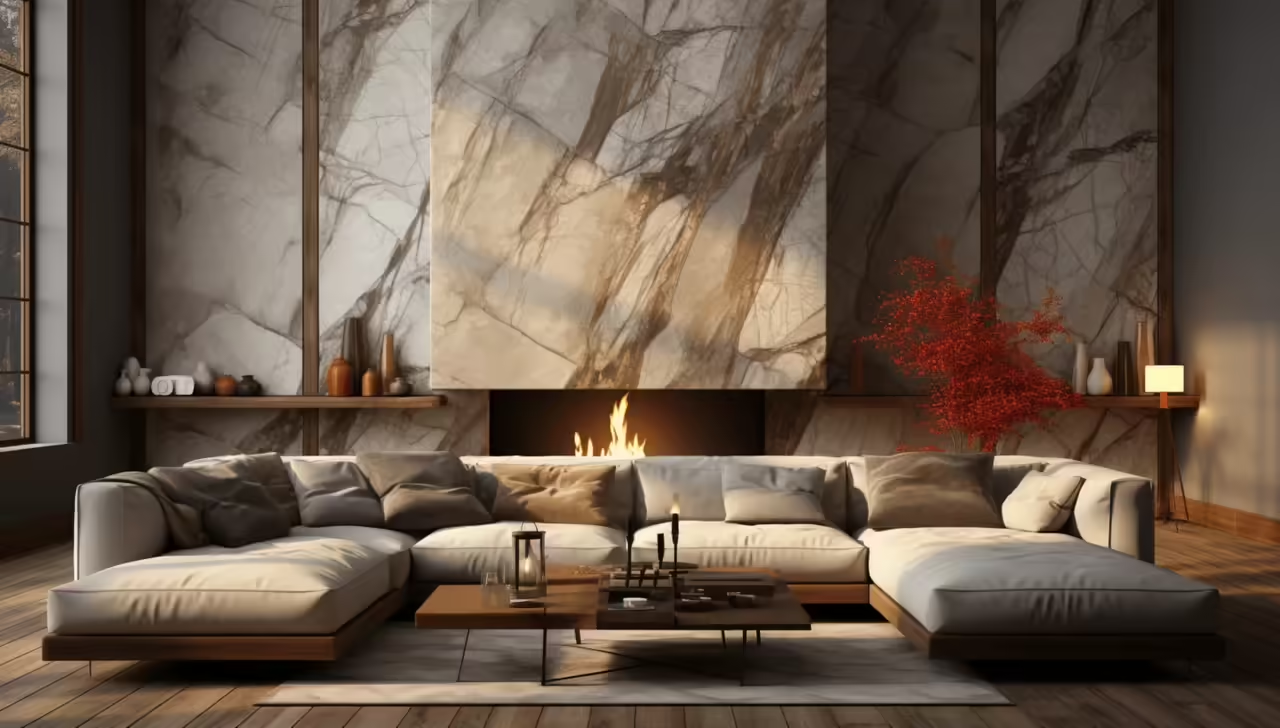
Home is much more than just four walls and a roof. It is a refuge, a place where we retreat to find peace, comfort, and serenity amidst the hustle and bustle of the outside world. In the current era, where we spend more time than ever within our homes, the importance of turning our personal spaces into sanctuaries of beauty becomes increasingly evident.
Exploring the Concept
What exactly is a sanctuary of beauty in the home? It’s more than just elegant decoration or attractive furniture. It’s the creation of an environment that nurtures the soul and uplifts the spirit. It’s a place where every corner is imbued with warmth and harmony, where the senses are delighted by soft colors, soothing aromas, and comforting textures.
Transforming a home into a sanctuary of beauty involves more than following the latest design trends. It’s about infusing the space with elements that resonate with our deepest essence, that reflect our personality and lifestyle. It’s an intimate and personal process that goes beyond the visual, seeking to create a sensory experience that nurtures the body, mind, and soul.
The Importance of Authenticity
In a world where uniformity often seems to be the norm, creating a home that is truly unique becomes essential. Each individual possesses a unique palette of tastes, experiences, and aspirations, and their home is the canvas on which they can fully express themselves. From the selection of colors and furniture to the incorporation of decorative elements and artworks, each choice contributes to the narrative of who we are and what we value.
By creating a space that reflects our authenticity, we not only create an attractive physical environment but also an emotional refuge where we can be ourselves without reservation. This sense of belonging and authenticity at home not only enhances our daily quality of life but also nurtures our self-esteem and overall well-being.
The Power of Transformation
Home transformation goes beyond the aesthetic; it has the power to positively influence all aspects of our lives. A carefully designed and curated environment can uplift our mood, boost our productivity, and foster deeper, more meaningful relationships with those we love. Furthermore, a sanctuary of beauty at home can serve as a constant reminder of our goals, values, and deepest dreams, inspiring us to pursue a life full of meaning and purpose.
Connection between Beauty and Home: Enhancing Well-being and Happiness
The environment in which we live has a profound impact on our mental, emotional, and physical health. Our home, in particular, plays a crucial role in our overall well-being and happiness. The connection between beauty and home extends beyond mere aesthetics; it extends to how the design and atmosphere of our environment can influence our quality of life and personal satisfaction.
Influence on Well-being and Happiness
A home that reflects our tastes and values can become a supportive refuge in times of stress and anxiety. Beauty and harmony in home design can have a calming effect on our minds, reducing cortisol and promoting relaxation. Soft colors, comfortable furniture, and intuitive spatial layout can create a cozy atmosphere that invites us to rest and recharge.
Additionally, a beautifully designed home can foster a sense of pride and satisfaction, elevating our self-esteem and self-confidence. Feeling comfortable in our environment can boost our motivation and creativity, allowing us to pursue our goals with renewed determination and passion.
Relationship with Personal Expression
Home design offers a unique opportunity to express our identity and personality tangibly. Every decoration choice, from furniture selection to arrangement of personal items, communicates something about who we are and what we value. By personalizing our space, we create an environment that empowers us and makes us feel authentic.
Personal Expression through Home Design not only allows us to showcase our individual style but can also serve as a therapeutic process of self-discovery and growth. By making conscious decisions about the aesthetics and functionality of our environment, we can explore our tastes and preferences, as well as discover new passions and interests.
Additionally, the ability to design our own space grants us a sense of control over our lives, especially in a world that often seems chaotic and unpredictable. By exercising this form of self-determination, we strengthen our sense of autonomy and empowerment, which in turn contributes to our emotional and mental well-being.
Personal Style and Décor: Discover Your Essence in Home Design
The process of decorating a home goes beyond simply choosing attractive furniture and accessories; it’s about expressing your personality and unique style through design. Here are some tips to help you identify and define your own decorating style, as well as select furniture and accessories that reflect your true essence.
Identifying Your Personal Style
Take inventory of your preferences: Take note of things that attract you in other spaces, whether in magazines, social media, or friends’ homes. Are you more drawn to classic, modern, rustic, or eclectic styles?
Reflect on your personality: Are you a creative and artistic person? Do you like neat and minimalist spaces or prefer a more cozy and detailed environment?
Consider your lifestyle: Think about your daily activities and how they influence your design needs. For example, if you are an entertainment lover, you may want an open and comfortable space to entertain your guests.
Observe your wardrobe: How you dress can offer clues about your aesthetic preferences. Do you lean towards classic and timeless garments or feel more comfortable with bold and avant-garde styles?
Defining Your Décor Style
Compile inspiration: Create an idea folder with images of interiors that inspire you. Identify common elements in these images, such as colors, textures, and furniture styles.
Try different styles: Experiment with different decoration styles on a small scale before committing to a specific style. Visit decoration stores, design fairs, and furniture exhibitions to explore a variety of options.
Be consistent: As you define your style, make sure all the elements in your home harmonize with each other. This doesn’t mean everything has to be of the same style, but there should be a visual cohesion that ties all the pieces together.
Selecting Furniture and Accessories that Reflect Your Personality
Choose meaningful pieces: Opt for furniture and accessories that have special meaning to you. Whether it’s a piece inherited from a loved one or an artwork that inspires you, incorporating personal items into your decoration will add depth and authenticity to your space.
Prioritize comfort and functionality: While style is important, don’t sacrifice comfort and functionality for aesthetics. Select furniture that fits your lifestyle and is comfortable and practical for everyday use.
Add personal touches: Details make the difference. Add decorative elements such as cushions, blankets, plants, and artworks that reflect your interests and passions. These personal touches will add warmth and character to your home.
Organization and Order in the Home
Creating Harmonious Spaces: Maintaining order and organization in the home not only contributes to aesthetically pleasing appearance but also promotes a peaceful and stress-free environment. Here are some strategies to maintain order and organization, as well as ideas to optimize storage space in an aesthetic and functional way.
Strategies for Maintaining Order and Organization: Develop cleaning and organization routines: Dedicate a few minutes each day to tidy up key areas of your home, such as the kitchen, bathroom, and living room. Establish daily or weekly routines for tasks like surface cleaning, clutter removal, and object organization will help you maintain order consistently.
Use containers and organizers: Transparent containers and organizers are useful tools for keeping small items tidy and easily accessible. Use baskets, storage boxes, and drawer dividers to group and organize similar items, such as toys, underwear, cleaning products, and office supplies.
Adopt the “one in, one out” rule: Before adding new items to your home, take a moment to assess if you really need them. If you decide to acquire something new, consider getting rid of a similar item that you no longer use or need. This will help you avoid unnecessary accumulation of objects and keep clutter under control.
Assign a place for everything: Designate a specific place for each item in your home and make sure to return it to its place after using it. This will make the task of maintaining order easier and prevent objects from scattering throughout the house.
Ideas for Optimizing Storage Space
Take advantage of vertical space: Use shelves, floating shelves, and tall cabinets to make the most of the vertical space available in your home. This will allow you to store a greater number of items without taking up too much floor space.
Invest in multifunctional furniture: Furniture that offers integrated storage, such as beds with drawers underneath, coffee tables with hidden storage space, and benches with storage compartments, are excellent options for maximizing storage space in small areas.
Use custom storage solutions: Consider installing floating shelves, built-in wardrobes, and custom storage systems to make the most of every inch of available space in your home. These solutions can be tailored specifically to your needs and maximize storage efficiency.
Maintain a consistent aesthetic: Opt for containers, baskets, and organizers that complement your home decor and contribute to a harmonious aesthetic. Choose materials and colors that integrate well with the overall style of your decor to create a visually appealing and inviting atmosphere.
Ambient Lighting: Creating Cozy and Attractive Atmospheres
Lighting is a fundamental element in interior design, as it not only serves a practical function by providing light but also plays a crucial role in creating cozy and attractive atmospheres in the home. Here we will explore the importance of lighting in setting the mood of the space and provide some tips for using it effectively in different areas of the home.
Importance of Lighting in Creating Atmospheres: Define the Atmosphere: Proper lighting can define the atmosphere of a room, whether warm and cozy for a relaxing night or vibrant and energetic for a social gathering. Color temperature and light intensity can influence how we feel and perceive a space.
Highlight Features: Well-planned lighting can highlight architectural features, artworks, or standout furniture, adding visual interest and depth to the space.
Create a Sense of Space: Strategic lighting can make a room feel larger and airier by focusing light on specific areas and avoiding dense shadows.
Improve Well-being: Proper lighting can improve overall well-being by regulating circadian rhythms and promoting healthy sleep. Natural light during the day and softer, warmer lighting at night can help establish a regular sleep cycle and reduce stress.
Tips for Using Lighting Effectively
Vary the Intensity: Use a combination of main lights, accent lights, and decorative lights to create layers of light that add depth and dimension to the space. Varying the intensity of the light also allows you to adjust the atmosphere according to the occasion and needs.
Play with Color Temperature: Experiment with different color temperatures, from warm tones like yellow and amber to cool tones like bluish-white, to create the desired atmosphere in each room.
Use Dimmer Switches: Install dimmer switches on main lights to have control over the amount of light in a room. This will allow you to adjust the lighting according to the time of day and activities being carried out.
Illuminate Work Spaces: Make sure to have adequate lighting in areas where tasks requiring concentration are performed, such as the office desk or kitchen countertop. Direct and bright light is ideal for these areas to avoid visual fatigue.
Take Advantage of Natural Light: Maximize the use of natural light during the day by opening curtains and blinds. Natural light is not only more visually pleasant but also helps reduce energy consumption.







